|
Sukhoi T-4 "Sotka"
by "Bondo" Phil Brandt
|
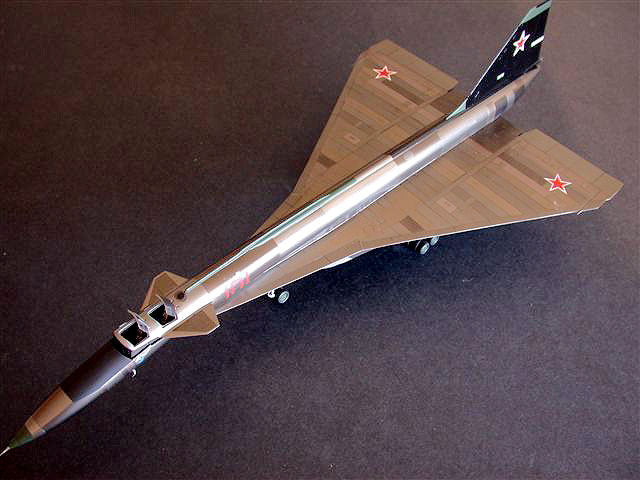 |
|
Sukhoi T-4 Sotka |

HyperScale is proudly supported by
Squadron.com
Although Premier Nikita Kruschev was firmly dedicated to
furthering missile force development at the expense of the Soviet
aviation industry, even he had to bow in deference to Sixties
American aviation technology. Particularly required was an
intercontinental strike/reconnaissance weapons platform operating in
the Mach 3 regime.
If the technology race with America was stressful to Soviet
planners, no less so was the fierce infighting between the Tupolev
and Sukhoi design bureaus to create such a cutting edge machine. In
the end, Pavel Sukhoi, Tupolev's brilliant former student, got the
nod to start development of what would become the T-4 "Sotka", or
Project 100 (one hundred tons gross weight).
Although the resultant 1964 Sukhoi design resembles the North
American XB-70 in main respects such as delta wing planform, a
swanlike tubular forward fuselage with canards and a row of
aft-mounted engines, the two designs seem to have been reached
independently, and the T-4 is approximately 2/3 the size of the
Valkyrie. A significant difference between the American and Soviet
efforts was the variable forward fuselage geometry to allow triple
Mach operations but yet allow normal vision during landing
approaches. The XB-70 used a large, tilting windscreen, but the
Soviets incorporated a gigantic articulating forward fuselage, about
twenty feet worth! The highspeed forward fuselage configuration was
sleek and rocketlike in appearance, but aesthetics didn't seem to
apply in the case of the T-4 low speed configuration; the
three-panel vertical windscreen, revealed when the forward fuselage
tilts down about ten degrees, resembles a tugboat bridge more than
an airplane. UUUUGLY!!
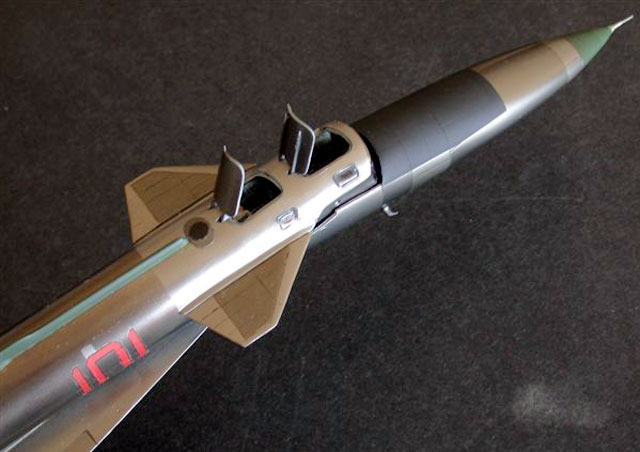
Although six T-4 prototypes and, later, up to 250 operational
airframes were planned, only the first and second prototypes were
finished. "Black 101", the first prototype, and the only one to fly,
lifted off in 1972, on the first of what would become a relatively
uneventful ten-flight, ten-hour program.
Although the largely titanium Sotka boasted many firsts in Soviet
aviation: fly-by-wire (the world's first); nitrogen purging of fuel
cells; and auto throttle control for landing approaches, "sticker
shock" had set in with Soviet planners, and it was all but over for
the T-4. Although Andrei Tupelov had lost the initial battle of
which bureau would design and build the new strike/reconnaissance
platform, he won the 'war' by cleverly planting financial doubt in
the minds of Soviet planners, convincing them that modifying the
existing Tu-22 Blinder force would be much quicker and more cost
effective than starting from scratch. But what Tupelov didn't
initially reveal was that the "modified" Blinder would in reality be
a whole new airframe, the Tu-22M "Backfire." Fortunately Black 101,
the only remaining Sotka, has been preserved at the VVS Monino
Museum.
A
Model's 1/72 Scale T-4 "Sotka" |
This is the 1/72 A Model Sukhoi T-4 "Sotka".
This limited production kit (only 200 copies worldwide) is,
construction-wise, truly one of the most unusual Bondo has built.
Because this is such a gigantic airframe - it is easily equal to two
large 1/48 fighters - Russia-based Amodel opted to create the
central fuselage and wing 'hull' in one monolithic, hand-laid epoxy
resin fiberglass assembly, complete with engraving; the main portion
of the vertical fin is epoxy fiberglass too! The forward fuselage,
canards, wing and vertical fin leading edges and control surfaces,
and tailcone are injected plastic, as are all other accessories such
as landing gear and variable geometry inlets. Engraving of the
central fuselage/wing assembly is a bit heavy, uneven around some
panels, but generally acceptable, especially if a multi-shade
natural metal finish is done, and this airplane has lots of varied
titanium panels. Some parts of the epoxy fiberglass hull must be cut
off with a razor saw before construction begins.
CA Glue is Our Friend...
The joining of long lengths of epoxy and plastic requires lots of
CA glue and some rapid assembly techniques to ensure that alignment
is maintained, a tough assignment. I coated one joining surface with
accelerator and the other with CA. Later, I experienced numerous 'debonding'
instances, especially with the wing leading edges and flying
surfaces, and can only attribute it to the dissimilar materials.
Fits Over Fit
I wasn't expecting Tamiyagawa 'fall together' excellence from
this big Amodel release, and I'm sorry to report that Bondo's
lowered expectations were met! As with some other limited production
kits, parts fit is not a plus--downright poor in some instances:
injected fuselage halves-to-epoxy-resin-central component;
three-window windscreen; elevons to wing; maingear strut assembly to
fuselage. Bondo is glad there's lots of 3M Blue Acryl putty on his
garage shelves!
Especially aggravating were the twelve cast-in hinge fairings
integral with the lower surface of the elevons which did not permit
the elevons to be CA-glued flush with the wing upper and lower
surfaces. All twelve hinges had to be cut off and painstakingly
superglued onto the main wing section after the elevons were
attached.
Cockpit
The cockpit components are fairly crude and undersized, so I
plowed into the plastic parts repository, and found that the
Monogram 1/72 SR-71 forward instrument panel and consoles from both
cockpits are larger and much more realistic; altering them to fit--I
used the kit's aft instrument panel as is--was no problem. To add
"busy-ness" to the fairly large open cockpits (and since there's
only one of these suckers in the world, with no interior pix of
which I'm aware) I adapted 1/72 resin F-4 sidewalls from the old
Verlinden detail set. Add to that a coupla aftermarket resin K-36
seats (remove the stabilizer canisters on either side of the
headrests), and we're cookin'.
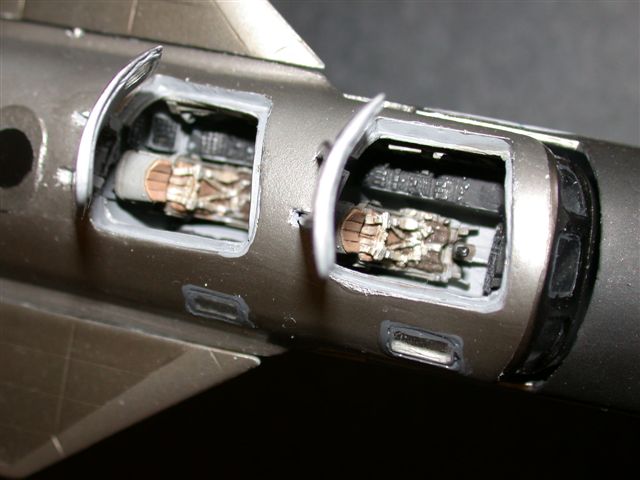
The real crew hatches open fore and aft, so it's surprising that
Amodel instead arranged them to open sideways! I'll never understand
how when, as I said, there's only one of these T-4s in the world,
and the Russian-produced kit of same is done with what I would
presume is some degree of nationalistic pride, and when there's an
excellent Russian mag (Aviatsiya) article with giant fold-out 1/72
detailed drawings of every panel on this big hunk of Titanium,
details such as this could be gotten wrong. But, Bondo digresses. I
scratchbuilt aft-located hatch hinges, plus new strakes on top of
the forward hatch and milled narrow receiver slots in the rear of
each compartment. I also rebated around the hatch edges for a more
3D look--real world crew entrance hatches and canopy edges are
rarely thin.
Fuselage
Fit of the vertical, three-window windscreen panel is especially
poor, as is the articulating nosecone, especially if you opt for the
highspeed, "up" position. Although the landing configuration reveals
the gross 'tugboat' windscreen, it adds variety, plus it's the way
the bird's displayed in Moscow, so Bondo opted for 'ugly'. And, the
cast-in detent 'holes' need to re-drilled to allow the nosecone to
depress to the proper angle.
Because of poor fit and shape, I scratchbuilt a new long antenna
strake on the fuselage top aft of the cockpit. The crude plastic rod
that is supposed to be the radome pitot tube was deep-sixed in favor
of stainless tube and brass rod.
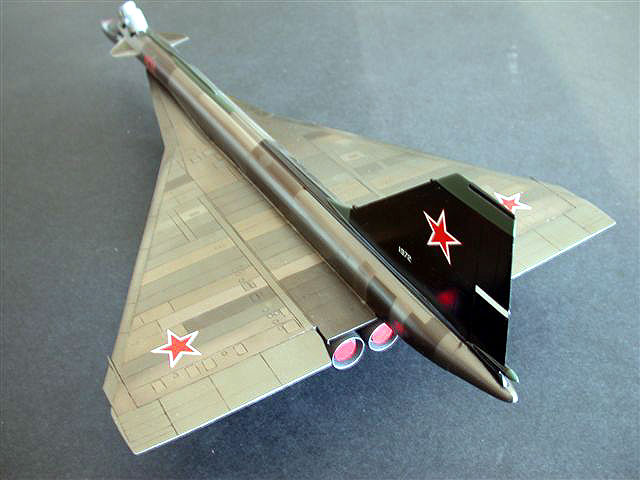
The XB-70 lookalike intakes on the T-4 are a plastic multipiece
assembly, with no tunnels leading back through the cavernous
interior to the four line abreast engines. Sooo, the way to go is to
do FOD covers, the dimensions for which are conveniently included in
the instructions. Additionally, large orange-red decal rectangles
are provided for said covers. Same, same for the rather crudely
cast, four-piece exhaust assemblies. Dimensions for the exhaust
circular FOD covers, and decals, are provided. The real pain here is
in the excessive flash in the afterburner actuator 'fingers.' It
took at least an hour to clean 'em up, and they're unfortunately not
covered by the FOD plates.
Landing Gear
Wheel wells are very shallow, really just a hint of depth, but
the open part is not that large, so the injected gear doors will
cover most of this shortcoming. Large, plastic maingear doors glue
into recesses in the fuselage slab sides.
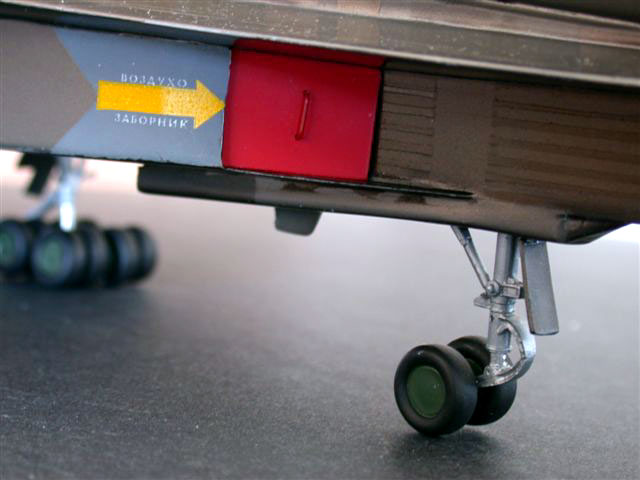
Landing gear struts and braces are decently detailed, but will
need flash cleanup, too. The maingear strut support rods were way
too short, and I had to glue 1/2" pieces of larger tube to the wheel
well roof to act as strut rod locators. The wheels are fairly plain,
but are overpowered by the sheer size of the airframe they support,
so not too noticeable.
Bondo's Natural Metal Finish of choice has been Alclad ever since
being introduced to it at the Albuquerque Nats, over five years ago.
I used six shades, some custom-mixed, with the burner cans done in
Testors Metallizer. The overall shade is Steel, because it mimics
best the dark, all-titanium construction of the Sotka.
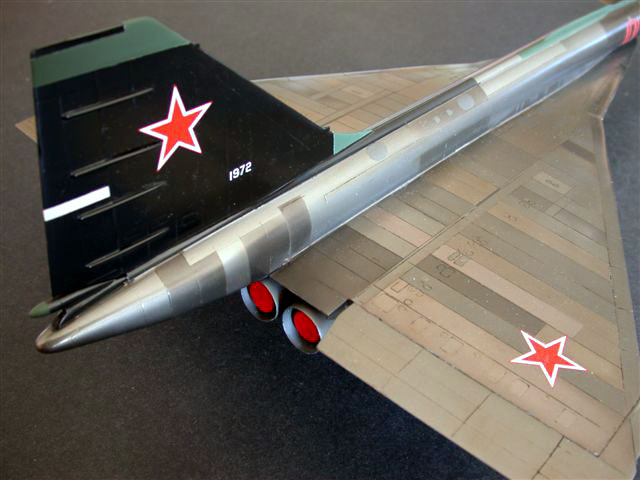
Unfortunately, I did experience some lifting during the intensive
masking (3M Drafting Tape) iterations. I feel that this rare, for
Alclad, glitch was due to the many sharp edges created by the
deeper-than-normal engraving on the multitude of wing panels,
especially where they meet the turn of the fuselage. My repair
method for small areas of lifted metallic finish is to overlay the
marred area with small panels cut out of decal paper pre-sprayed
with various shades of Alclad.
One factor mitigating in favor of the slight flaws found in the
epoxy glass engraved lines and in the less-than-sterling fit, is
that Russian airframe fit and finish of that era was more practical
than superlative.
After some appropriate burnt sienna wash, and we're off and
running!
Decals are very thin--too thin, actually, and too brittle and
translucent. There's no white backing as on excellent Aeromaster
sheets, and missing are some nitnoy pieces such as the horizontal
white stripe on the rudder and the "1972" in small white letters on
the vertical fin. Plus, the large intake warning placards are in
gray, whereas the pix in Wings of Fame plainly show the background
color to be black.
Because of the translucent yellow arrow on each placard, I had to
cut an additional yellow arrow out of a Superscale sheet and
laminate it on top of the first, an old trick I use on Collect-Aire
decals, also not known for opacity.
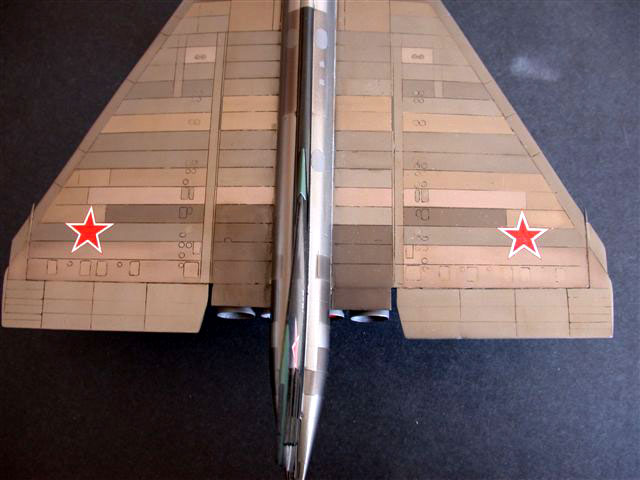
To top off the decal shortcomings, they've been done in the
maddeningly flat finish as seen in older ESCI kits. The coloring of
the orange-red FOD facings seemed to be somewhat weak, so I painted
the intake and burner can covers in Guards Red, adding a brass wire
handhold to each intake cover per Wings of Fame pix. Overall color
and registration of the other decals are OK and complete, but I
chose Aeromaster Soviet national insignia from the IL-2 sheet. I
also skipped the anti-glare panel decal on the nosecone in favor of
paint. So, the only kit-supplied decals I used were the Sukhoi
"Archer" logo, the large "1 0 1" red-trimmed-in-black fuselage
numbers (well trimmed because of the flat finish), and the
incorrectly colored intake placards, because the placards were
lettered in Cyrillic, and I wished to retain that 'flavor.'
The non-text instruction booklet is sharply printed, with numerous
assembly blowups and some small detail photos of the real thing.
Included are four complete airframe views for decal placement, and
Humbrol colors are called out.
This is not an easy kit, as the epoxy glass center section might
lead the modeler to believe. But, the Sotka's a genuinely rare
release of a Soviet aviation landmark, and it'll make a great
companion to the AMT/Ertl XB-70 that Bondo did way back. Amodel is
to be congratulated on such an energetic undertaking and production
initiative.
Review and Images Copyright © 2002 by
Phil Brandt
Page
Created 18 May, 2002
Last updated
04 June, 2007
Back to HyperScale Main
Page
Back to Reviews
Page
|
Home
| What's New |
Features |
Gallery |
Reviews |
Reference |
Forum |
Search